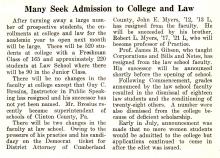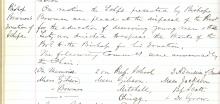Changes in Admissions: "no more women students" ...
The enrollments for the academic year following 1923 were expected to be large both for the College and Law school. It was expected that there would be 520 students at the College and that a large number of prospective students would be turned away.
Hence, early in July, an edict was issued stating that " NO more women students would be admitted to the college" (emphasis added). Nonetheless, applications from women aspiring to be admitted continued to arrive.






